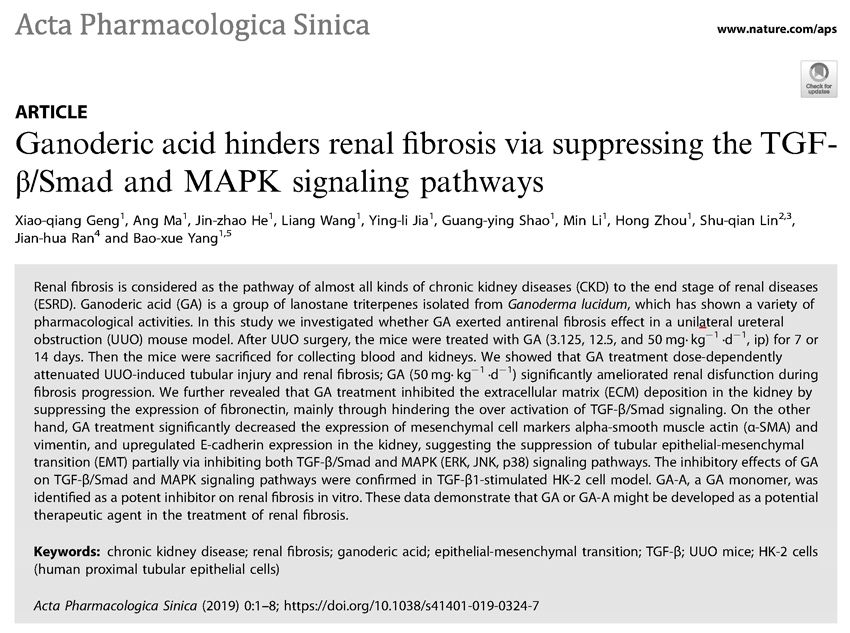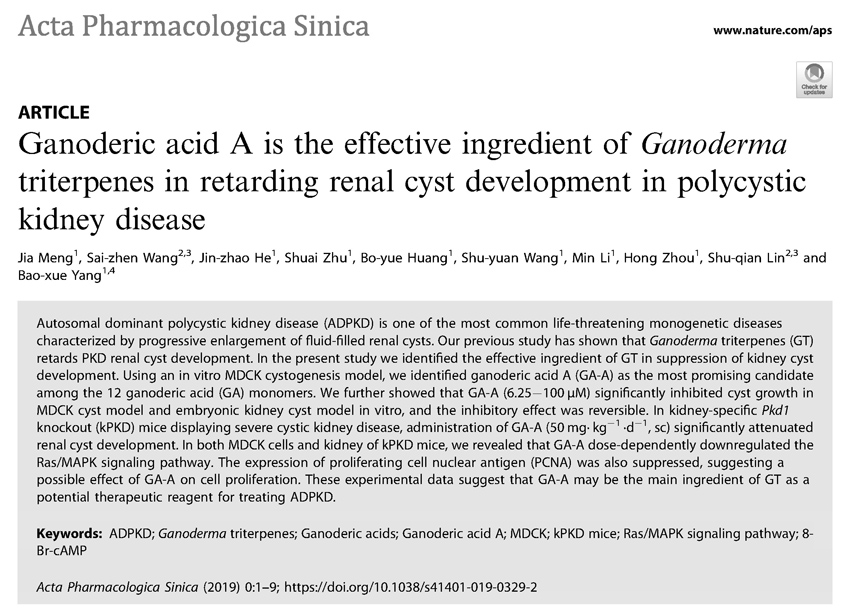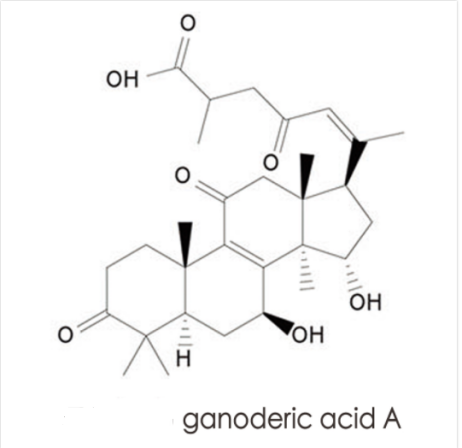January 2020/Peking University/Acta Pharmacologica Sinica
Text/ Wu Tingyao
The team led by Professor Baoxue Yang, chairman of the Department of Pharmacology, Peking University, published two articles in Acta Pharmacologica Sinica in early 2020, confirming that Ganoderma lucidum triterpenes can delay the progression of renal fibrosis and polycystic kidney disease, and their main functional components are ganoderic acid A.
Ganoderic acid delays the progression of renal fibrosis.

The researchers tied up the ureter on one side of the mouse. Fourteen days later, the mouse would develop renal fibrosis due to obstruction of urination and backflow of urine. At the same time, its blood urea nitrogen (BUN) and creatinine (Cr) will also increase, indicating impaired renal function.
However, if ganoderic acid is given at a daily dose of 50 mg/kg by intraperitoneal injection immediately after ligation of the ureter, the degree of renal fibrosis or renal function impairment will be significantly reduced after 14 days.
Further analysis of the related mechanism of action shows that ganoderic acid can prevent the progression of renal fibrosis from at least two aspects:
First, ganoderic acids prevent normal renal tubular epithelial cells from transforming into mesenchymal cells that secrete fibrosis-related substances (this process is called epithelial-to-mesenchymal transition, EMT); second, ganoderic acids can reduce the expression of fibronectin and other fibrosis-related substances.
As the most abundant triterpenoid of Ganoderma lucidum, Ganoderic acid has many kinds. In order to confirm which ganoderic acid exerts the above-mentioned kidney protection effect, the researchers cultured the main ganoderic acids A, B, and C2 with human renal tubular epithelial cell lines at a concentration of 100 μg/mL. At the same time, the growth factor TGF-β1, which is indispensable for the progression of fibrosis, is added to induce cells to secrete fibrosis-related proteins.
The results show that ganoderic acid A has the best effect in inhibiting the secretion of fibrosis-related proteins in cells, and its effect is even stronger than that of the original ganoderic acid mixture. Therefore, researchers believe that Ganoderma lucidum is the active source of reducing kidney fibrosis. It is especially valuable that ganoderic acid A has no toxic effect on renal cells and will not kill or injure renal cells.
Ganoderic acids delay the progression of polycystic kidney disease.

Unlike renal fibrosis, which is mostly caused by external factors such as diseases and drugs, polycystic kidney disease is caused by a gene mutation on the chromosome. The vesicles on both sides of the kidney will gradually become larger and more numerous so as to press on normal kidney tissues and impair kidney function.
Previously, Baoxue Yang’s team has proven that Ganoderma lucidum triterpenes can delay the progression of polycystic kidney disease and protect kidney function. However, the Ganoderma lucidum triterpenes used in the experiment at least include ganoderic acids A, B, C2, D, F, G, T, DM and ganoderenic acids A, B, D, and F.
In order to find out the key active ingredients, the researchers examined the 12 kinds of triterpenes one by one through in vitro experiments and found that none of them affect the survival of kidney cells but they have significant differences in the inhibition of vesicle growth. Among them, ganoderic acid A has the best effect.
Furthermore, ganoderic acid A was cultured in vitro with the kidneys of embryonic mice and the agents that induce vesicle formation. As a result, ganoderic acid A can still inhibit the number and size of vesicles without affecting the growth of the kidneys. Its effective dose was 100μg/mL, the same as the dose of triterpenes used in previous experiments.
Animal experiments have also found that subcutaneous injection of 50 mg/kg of ganoderic acid A into short-born mice with polycystic kidney disease every day, after four days of treatment, can improve kidney swelling without affecting liver weight and body weight. It also reduces the volume and number of renal vesicles, so that the distribution area of renal vesicles is reduced by about 40% compared with the control group without ganoderic acid A protection.
Since the effective dose of ganoderic acid A in the experiment was one-fourth of the same experiment with Ganoderma lucidum triterpenes, it is shown that ganoderic acid A is indeed the key component of Ganoderma lucidum triterpenes to delay the progression of polycystic kidney disease. Applying the same dose of ganoderic acid A to newborn normal mice did not affect the size of their kidneys, indicating that ganoderic acid A has a certain degree of safety.
From renal fibrosis to renal failure, it can be said that chronic kidney disease caused by various causes (such as diabetes) will inevitably go on a path of no return.
For patients with polycystic kidney disease, the rate of renal function decline may be faster. According to statistics, about half of patients with polycystic kidney disease will progress to kidney failure around the age of 60 and require life-long dialysis.
Regardless of whether the pathogenic factor is acquired or congenital, it is not easy to “reverse the kidney function”! However, if the rate of kidney deterioration can be slowed down so that it can be balanced with the length of life, it may be possible to make the diseased life less pessimistic and more scenic.
Through cell and animal experiments, Baoxue Yang’s research team has proved that Ganoderic acid A, which accounts for the highest proportion of Ganoderma lucidum triterpenes, is an indicator component of Ganoderma lucidum for protecting the kidney.

This research result highlights that the scientific research of Ganoderma lucidum is so solid that it can tell you which ingredient the effects of Ganoderma lucidum mainly come from instead of just drawing a fantasy pie for your imagination. Of course, it is not to say that only ganoderic acid A can protect the kidney. In fact, some other ingredients of Ganoderma lucidum are definitely beneficial to the kidneys.
For example, another paper published by Baoxue Yang’s team on the topic of protecting the kidney pointed out that Ganoderma lucidum polysaccharide extract can reduce oxidative damage to the kidney tissue through its antioxidant effect. The “Ganoderma lucidum total triterpenes”, which contain various triterpenoids such as ganoderic acids, ganoderenic acids and ganoderiols, work together to delay the progression of renal fibrosis and polycystic kidney disease, which also surprises scientists.
What’s more, the need for protecting the kidney is not solved by protecting the kidney alone. Other things such as regulating immunity, improving the three highs, balancing endocrine, calming the nerves and assisting sleep are certainly helpful for protecting the kidneys. These respects cannot be completely solved by ganoderic acid A alone.
The preciousness of Ganoderma lucidum lies in its diversified ingredients and versatile functions, which can coordinate with each other to produce the best balance for the body. In other words, if the ganoderic acid A is lacking, the kidney protection work will lack a lot of combat force like a team lacking the main players.
Ganoderma lucidum with ganoderic acid A is more worthy of our expectations because of its better kidney-protecting effect.
[Data Source]
1. Geng XQ, et al. Ganoderic acid hinders renal fibrosis via suppressing the TGF-β/Smad and MAPK signaling pathways. Acta Pharmacol Sin. 2020, 41: 670-677. doi: 10.1038/s41401-019-0324-7.
2. Meng J, et al. Ganoderic acid A is the effective ingredient of Ganoderma triterpenes in retarding renal cyst development in polycystic kidney disease. Acta Pharmacol Sin. 2020, 41: 782-790. doi: 10.1038/s41401-019-0329-2.
3. Su L, et al. Ganoderma triterpenes retard renal cyst development by downregulating Ras/MAPK signaling and promoting cell differentiation. Kidney Int. 2017 Dec; 92(6): 1404-1418. doi: 10.1016/j.kint.2017.04.013.
4. Zhong D, et al. Ganoderma lucidum polysaccharide peptide prevents renal ischemia reperfusion injury via counteracting oxidative stress. Sci Rep. 2015 Nov 25; 5: 16910. doi: 10.1038/srep16910.
END
About the author/ Ms. Wu Tingyao
Wu Tingyao has been reporting on first-hand Ganoderma lucidum information since 1999. She is the author of Healing with Ganoderma (published in The People’s Medical Publishing House in April 2017).
★ This article is published under the exclusive authorization of the author
★ The above works cannot be reproduced, excerpted or used in other ways without the authorization of the author
★ Violation of the above statement, the author will pursue its related legal responsibilities
★ The original text of this article was written in Chinese by Wu Tingyao and translated into English by Alfred Liu. If there is any discrepancy between the translation (English) and the original (Chinese), the original Chinese shall prevail. If readers have any questions, please contact the original author, Ms. Wu Tingyao.



